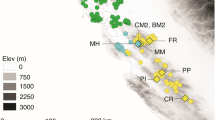Abstract.
Evidence indicates that sexually deceptive Chiloglottis R.Br. (Orchidaceae) taxa specifically attract their thynnine wasp (Tiphiidae) pollinators through the floral odour mimicry of female wasp sex pheromones. We use amplified fragment length polymorphisms (AFLPs) to reconstruct the species-level phylogeny of Chiloglottis, make a preliminary evaluation of genetic distinctions between species, and compare the historical association among orchids and their pollinators using wasp sequence data from a previous study. AFLPs show large differences between three sub-generic clades relative to that found among species within each clade. Interspecific genetic barriers are indicated by AFLP discontinuities among species unlike in previously reported DNA sequence data. However, such barriers are demonstrated clearly in only one of the two pairs of sympatric species sampled more intensively. We interpret these patterns as indicating either (i) a rapid and recent radiation of species within each clade following histories of stasis or extinction, or (ii) alternating cycles of divergence and gene flow acting to homogenize genetic differences among species within each of the three clades.
Similar content being viewed by others
Author information
Authors and Affiliations
Corresponding author
Rights and permissions
About this article
Cite this article
Mant, J., Peakall, R. & Weston, P.H. Specific pollinator attraction and the diversification of sexually deceptive Chiloglottis (Orchidaceae). Plant Syst. Evol. 253, 185–200 (2005). https://doi.org/10.1007/s00606-005-0308-6
Received:
Accepted:
Published:
Issue Date:
DOI: https://doi.org/10.1007/s00606-005-0308-6




